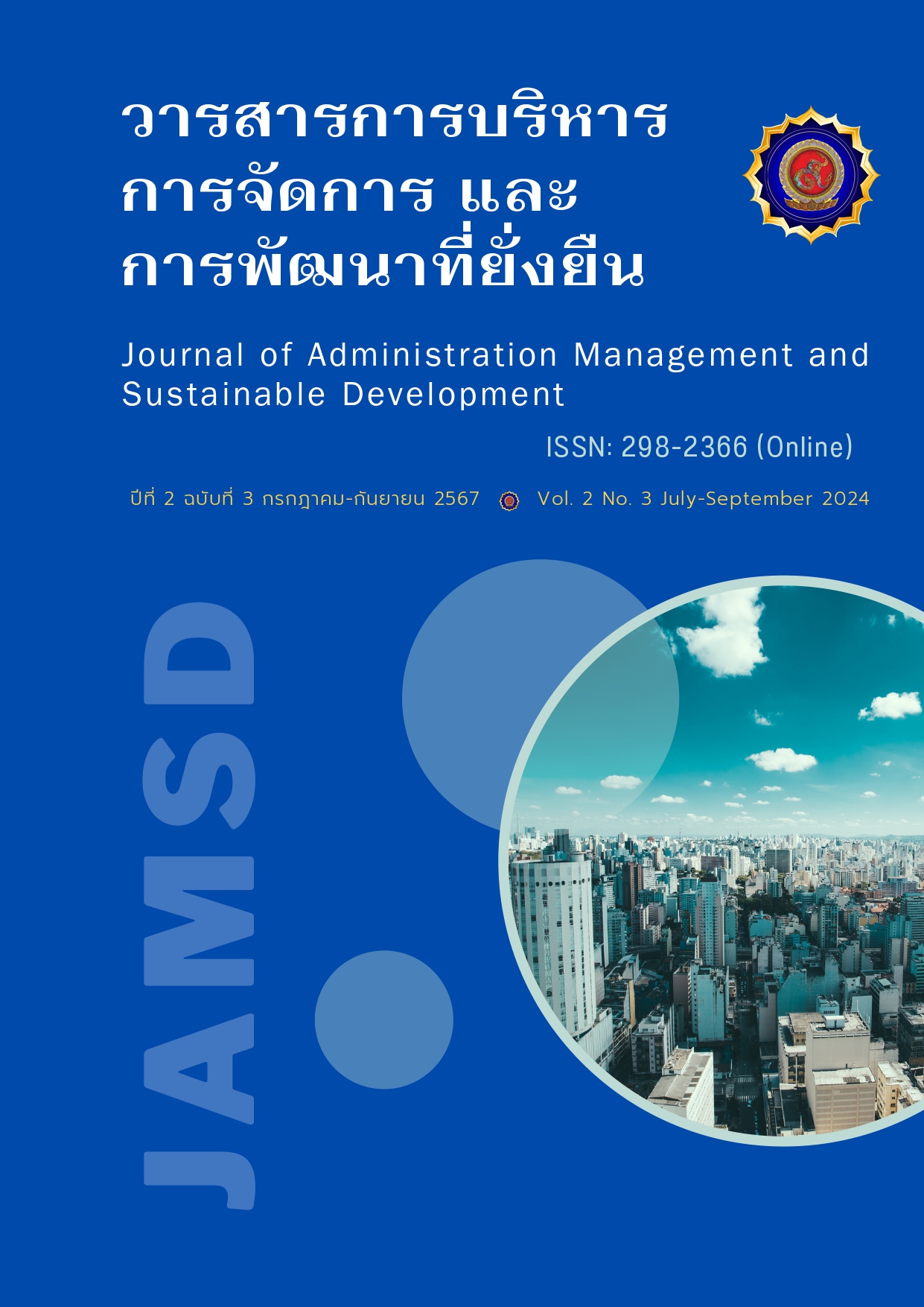Adapting local administrative organizations to bureaucracy 4.0 base on innovation
Keywords:
innovative government;, innovation;, government sector ;, new public services:Abstract
The Adaptation of Local Administrative Organizations in the Era of 4.0 This academic article aims to explain the concept of "Adapting Local Administrative Organizations in the 4.0 Era," focusing on studying the adaptation strategies of local administrative organizations within the context of the bureaucratic system and the role of innovation in enhancing efficiency and transparency in operations. This research employs
a descriptive and case study methodology, gathering data from local administrative organizations that have implemented technology and innovation in their management processes, including interviews with relevant stakeholders and document analysis. The research findings indicate that applying the principles of Bureaucracy 4.0 significantly improves the efficiency of local administrative organizations and enhances transparency. The use of digital technology, innovations in data management, and electronic systems play a crucial role in modernizing the organization and effectively responding to the needs of the public.
The study recommends promoting the continuous use of technology and innovation in local administrative organizations, as well as providing training and skill development for personnel to ensure the successful transformation toward Bureaucracy 4.0, thereby achieving the intended goals of improving efficiency and transparency in public sector management government, innovation, local government organizations, adaptation, bureaucracy 4.0, efficiency, transparency.
References
กระทรวงมหาดไทย. (2563). คู่มือแนวทางการพัฒนาองค์การสู่ระบบราชการ 4.0. กรมการพัฒนาระบบราชการ. สืบค้น 15 กันยายน 2567 จากhttps://www.opdc.go.th:contentReference[oaicite:0]{index= 0}:content Reference[oaicite:1]{index=1}.
กรมส่งเสริมการปกครองท้องถิ่น. (2563). รายงานการปรับตัวเพื่อการพัฒนาท้องถิ่น. กรุงเทพฯ: กรมส่งเสริมการปกครองท้องถิ่น.
กรมส่งเสริมการปกครองท้องถิ่น. (2562). รายงานประจำปี 2562. กรุงเทพฯ: กรมส่งเสริมการปกครองท้องถิ่น.
พัชรินทร์ ชื่นสมบัติ. (2564). โครงสร้างการบริหารในองค์กรปกครองส่วนท้องถิ่น. วารสารการบริหารการปกครองและนวัตกรรมท้องถิ่น, 8(2), 34-49.
สมาคมนักวิจัยท้องถิ่น. (2562). รายงานวิจัยปัญหาการบริหารท้องถิ่น. กรุงเทพฯ: สมาคมนักวิจัยท้องถิ่น.
สำนักงานเศรษฐกิจท้องถิ่น. (2563). เศรษฐกิจและการกระจายอำนาจ. กรุงเทพฯ: สำนักงานเศรษฐกิจท้องถิ่น.
สมาคมการปกครองท้องถิ่น. (2563). รายงานวิจัยพัฒนาการท้องถิ่น. กรุงเทพฯ: สมาคมการปกครองท้องถิ่น.
สถาบันการบริหารท้องถิ่น. (2564). การปรับตัวและการพัฒนาองค์กรปกครองส่วนท้องถิ่น. กรุงเทพฯ: สถาบันการบริหารท้องถิ่น.
สมาคมนักพัฒนาท้องถิ่น. (2562). รายงานการมีส่วนร่วมของประชาชนในท้องถิ่น. กรุงเทพฯ: สมาคมนักพัฒนาท้องถิ่น
สำนักงานคณะกรรมการพัฒนาระบบราชการ. (2562). คู่มือการพัฒนาระบบราชการ 4.0. สืบค้นจาก https://www.opdc.go.th.
Bannister, F., & Connolly, R. (2014). ICT, public values and transformative government: A framework and programme for research. Government Information Quarterly, 31(1), 119-128.
Brown, L. (2020). The impact of cloud computing on organizational efficiency. Journal of Information Technology, 27(3), 123-135.
Davis, F. D. (1989). Perceived usefulness, perceived ease of use, and user acceptance of
information technology. MIS Quarterly, 13(3), 319-340
Drucker, P. (1985). Innovation and entrepreneurship: Practice and principles. Harper & Row.
Schilling, M. A. (2019). Strategic management of technological innovation (6th ed.). McGraw-Hill Education.
Gil-Garcia, J. R., & Helbig, N. (2006). Exploring e-government benefits and success factors. Government Information Quarterly, 23(2), 187-216.
Jones, G. R., & George, J. M. (2020). Contemporary management (11th ed.). New York: McGraw-Hill Education.
Kang, S., & Schuett, M. A. (2019). Determinants of public sector innovation: Evidence from local governments in the United States. The American Review of Public Administration, 49, 911-924.
Krairit, D. (2021). Transforming local government towards public administration 4.0: A case of
sustainable resource management. Journal of Digital Government, 15(3), 215-230.
Li, X., & Zhang, Y. (2020). Modern project management systems and their impact on public sector efficiency. Public Administration Review, 80(4), 567-580.
Lee, G., & Kwak, Y. H. (2012). An open government maturity model for social media-based public engagement. Government Information Quarterly, 29(4), 492-503.
Lee, J., & Park, H. (2022). Blockchain technology and its implications for business security. International Journal of Business Innovation, 18(1), 78-92.
Smith, A., & Johnson, R. (2021). Automation and artificial intelligence in warehouse management. Logistics Management Review, 34(2), 45-59.
OECD. (2005). Oslo manual: Guidelines for collecting and interpreting innovation data (3rd ed.). Paris: OECD Publishing.
Osborne, S. P., Radnor, Z., & Nasi, G. (2013). A new theory for public service management Toward
a (public) service-dominant approach. The American Review of Public Administration, 43(2), 135-158.
Tambouris, E., et al. (2020). Smart city governance: Past, present, and future. Information Polity, 25(1), 1-16.
Pongsiri, N. (2019). The impact of digital technology on transparency in local governance. Journal of Public Sector Management, 22(1), 45-60.
Suwannarat, P. (2020). Adoption of smart technologies in local administration: A path towards efficiency and transparency. Local Government Journal, 10(2), 112-128.






